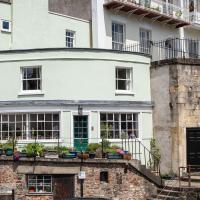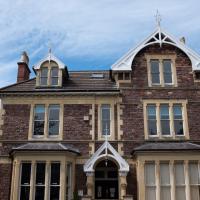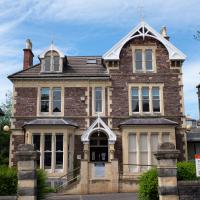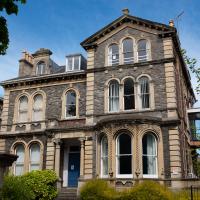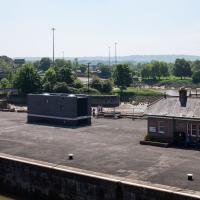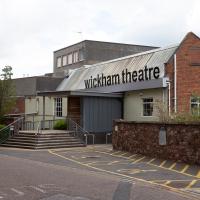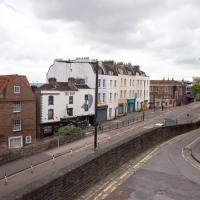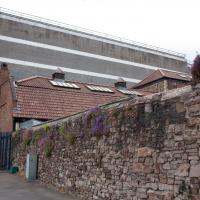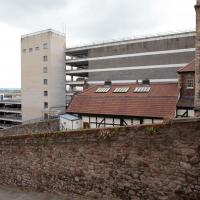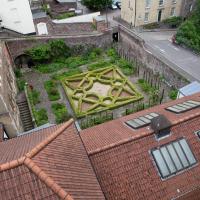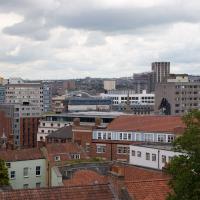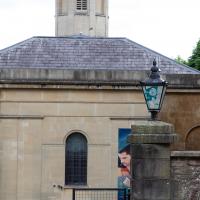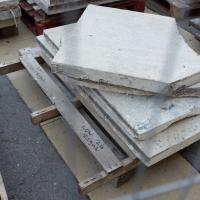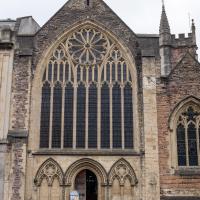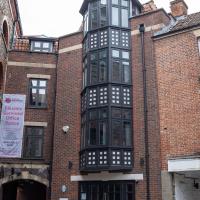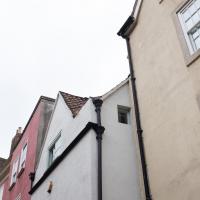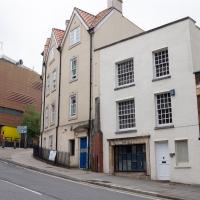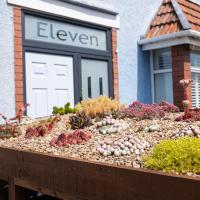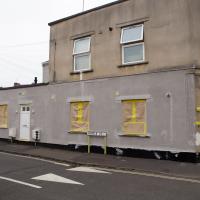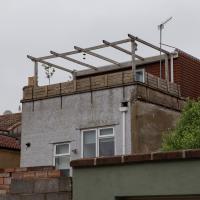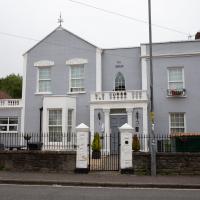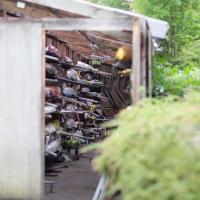Tagged: roof
The End of One Terrace and the Middle of Another
26 May 2021
Just a quick trip up to Clifton Village to enjoy a bit of sunshine and grab a coffee. No new roads, and only two pictures, but I did at least snap a plaque I'd missed related to some recent reading, and enjoy a quirky Clifton Village house.
I love this quirky little quarter-cylinder of house, with what looks like a sliver of wedge-shaped top floor behind it and the little below-pavement cellar space behind. I have no idea if the big black door on the right is also related to it, though on reflection it's probably more likely to lead to the under-stairs basement of 1 Royal York Crescent, up and to the right.
It and number two are clearly converted shops or pubs—number three remains The Portcullis pub, of course, and they all get a listing together. "Early C19. Render with limestone ashlar, party wall stacks and pantile hipped roof..."
I managed to knock off a reasonable chunk of the roads I had left to walk around the University at the north-eastern extremity of my mile on this nice sunny walk. As well as being impressed by the number of big townhouses now occupied by various departments, I took some time on my way there to check out a war memorial, and some time on the way back to do a little extra wandering of Berkeley Square.
An economist, and one of the first people to take the Tripos at Cambridge. She and Alfred Marshall, her former tutor, founded the teaching of economics at University College, Bristol.
Bank Holiday Street Art
31 May 2021
A nice warm Bank Holiday Monday saw me walk back over to Bedminster to do justice to something we glimpsed on my last wander. Along the way I spotted a couple of new pieces of street art tucked away on the south side of the Cumberland Basin Flyover system, so this turned into a micro-graffiti walk.
I guess they must be doing something to the Plimsoll Bridge—the door to the pivot mechanism base is behind there, I think.
A Longer-than-it-looks Walk With Lisa
06 Jun 2021
The track on the map doesn't tell the whole story of this walk with Lisa around and about Clifton, Berkeley Square, Brandon Hill and the harbourside, because the batteries on my GPS ran out while we were on the roof of Trenchard Street car park, it seems. Oh well. I think I did most of the area I was interested in finishing off around the University; there were only a few new bits around Brandon Hill that won't be on the track, and I can easily do them again.
Still, technology woes aside it was a nice walk, albeit a bit warm for climbing all those hills, and sat on the harbourside watching the world go by for a while, too. It was good to see the Bristol Ferry Boats carrying people around again, especially.
No idea why there's a window in this wall. The wall looks a lot older than everything surrounding it, so perhaps it's just some historical vestige leftover in between bits of University development.
Again, tempted out of my one-mile radius by the prospect of a new viewpoint. There at the top of the hill is the Red Lodge, where I wanted to go and have a look at the "wigwam" in the back garden. (Spoilers: it's not actually a wigwam.)
The "wigwam" is actually a structure along the lines of a Gloucestershire tithe barn.
The building I was interested in is the one with those skylights. It's the "wigwam" of an artists' collective that was until quite recently called the Bristol Savages and used native American imagery quite strongly in its branding, and also didn't let women in, apparently.
They were somewhat roasted for this behaviour and have now emerged as Bristol 1904 Arts instead.
I have no tomahawk to grind here; I was merely interested in a former member, Donald Hughes, who painted some interesting scenes of Bristol and whom I believe may have been a member of the Stella Matutina, a long-defunct secret society I'm interested in. (It's a long story.)
I was completely wrong in my guess about the little silver piple in the mid-distance; it's not the Airstream trailers on the roof of the boutique hotel in St Nick's; Lisa was right that it's too far to the left in this view. It is, in fact, the roof of Cabot Circus, much further away.
In my defence, it was harder to see with the naked eye, especially as my naked eyes don't work very well anyway...
A Trip to the Library
08 Jun 2021
I had to return a book to the library—Ellic Howe's Magicians of the Golden Dawn, very interesting, thanks for asking—so I decided to pick the Central Library as my drop-off point and walk down a segment of Deanery Road that I've surprisingly overlooked so far. In any normal time I'd have been walking to work that way quite often, or heading through at the weekend on the way to do some shopping in the city centre, or for a coffee at St Nick's, but those excursions have been quite thin on the ground for the last year or so, for obvious reasons.
I've never been inside a single building on Deanery Road itself; the Library is technically on College Green and the rest is mostly student accommodation or Bristol College buildings, by the looks of things. It's a fairly mediocre street, used merely to get to other places. (St George's Road, which merges into it, at least has the distinction of several good shops verging from the practical and long-lived car radio fitters to the excellent little Dreadnought Books, sadly currently closed for refurbishment...)
After dropping off my book I came home via the harbourside, the better to enjoy the nice sunny blue skies of the day.
Leigh Woods Solo
19 Jun 2021
I hadn't really planned to go out for a wander yesterday; I just got the urge and thought "why not?" (Well, the weather forecast was one possible reason, but I managed to avoid the rain, luckily.)
I wanted to finish off the A369—as it turns out I may still have a small section to go, but I've now walked the bulk of it out to my one-mile radius—and also a few random tracks in Leigh Woods. I'm still not really sure that I'm going to walk them all, especially after discovering today that "the map is not the territory" applies even more in the woods, where one of the marked tracks on the map wasn't really that recognisable as a track in real life... I'm glad I'd programmed the route into the GPS in advance!
Anyway. A pleasant enough walk, oddly bookended, photographically at least, by unusual vehicles. Leigh Woods was fairly busy, especially the section I'd chosen, which was positively dripping with teenage schoolkids with rah accents muttering opprobrium about the Duke of Edinburgh. I'm presuming the harsh remarks were more about taking part in his award scheme than the late Consort himself, but I didn't eavesdrop enough to be certain...
Library, Bookshop, Coffee
03 Jul 2021
I was headed into town to return RA Gilbert's biography of AE Waite to the library and along the way I noticed that Dreadnought had finished their refurbishment, but wouldn't be open until midday. That left me some time to kill, so I bimbled around the old St Augustine's/Gaunt's area for a while, then headed up Park Street for a coffee and a snack to eat on Brandon Hill before heading home the way I'd came so I could pop in and buy a pamphlet on the Hot Well I'd been interested in for a while.
According to the little blue plaque (there's a close-up in a couple of photos' time) this building won a Bristol Civic Society award in 1991. Not sure what for. Terrifying mock-Tudorness?
This is, of course, the route of the Carmelite pipe. I think this is the spot where it uses a siphoning action to run uphill for a bit.
A Cliftonwood Revisit with Lisa
10 Jul 2021
Lisa had a couple of hours to spare before going up in a hot air balloon (exciting!) so we went for a quick local walk, revisiting a bit of Cliftonwood we've seen before, exploring the secret garden I'd visited before that I thought she'd enjoy (I didn't take any new photos there) and then pushing on to another garden, Cherry Garden. Last time we passed this way, I'd noticed the gate, but we hadn't gone in as I'd assumed it was private. I'd since found it on CHIS's list of communal gardens in Clifton, so I wanted to have a look inside this time, and try to figure out whether it was private-communal or public, and possibly Council-owned, like several of the other gardens in Clifton.
Pastures New!
17 Jul 2021
Okay, not much in the way of actual pasture to be had in Bedminster these days, like most of Bristol, but I did take advantage of the current rather toasty weather in Bristol to go and sit under a tree in Greville Smyth Park to read a book for a while before firing up the GPS and taking a little detour around some back streets of Ashton and Bedminster rather than going straight to Coffee #1 for an espresso frappé. This is the first walk in a while where I've actually crossed off an entire new street (the frankly unexciting Carrington Road) as well as exploring a couple of back alleys, just because they were there, really. Along the way I spotted a few examples of graffiti of various qualities, including a live work-in-progress by SNUB23 on Ashton Road and the finished Six Sisters project on North Street.
With bonus transom. I thought I might have snapped the transom before, but I think I was thinking of this one.
A Journey to the Far East
25 Jul 2021
The far east of the intersection of my one-mile radius and Bedminster, anyway. I was feeling a bit tired this morning, so I motivated myself to get out of the door by imagining one of Mokoko's almond croissants. That got me on my way, and I wandered across to Bedminster, through Greville Smyth Park, along most of the length of North Street (looking out for new Upfest 75-pieces-in-75-days artwork as I went) and then onto some new roads at the far end.
I only wanted to knock a few streets off my "to do" list, but by the time I'd diverted here and there to check out various bits of graffiti and other attractions and come back via the aforementioned purveyors of Bristol's finest croissants, I'd walked 7.4km. Not bad for someone who woke up tired, and at least I've done something with my day. I'm very glad the weather broke (we had tremendous thunderstorms yesterday), even if some of the pictures might've looked better with a blue sky. I was getting fed up with walking around in 29°C heat...
It has many good reviews on Tripadvisor. Certainly looks well-kept. This area, especially Coronation Road, is quite well-known for its reasonably-priced bed-and-breakfasts.
